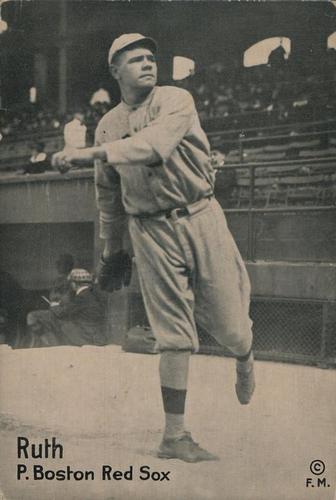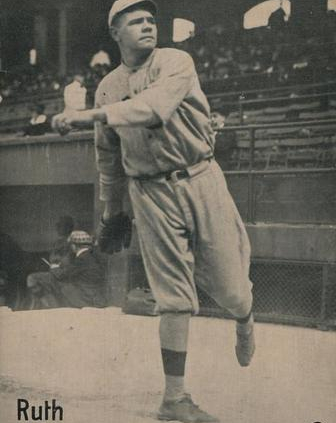July 18, 1919: Babe Ruth’s game-winning grand slam leads to Tris Speaker’s managerial career
 In 1915 veteran center fielder Tris Speaker and rookie pitcher Babe Ruth joined forces to help the Boston Red Sox win the World Series. After that season’s success, Red Sox President J.J. Lannin wanted to cut Speaker’s salary from $18,000 a year to $9,000 because Speaker’s batting average had declined for three seasons in a row and was “only” .322.1 Speaker balked at signing for a lower salary, and as a result, he was traded to the Cleveland Indians.
In 1915 veteran center fielder Tris Speaker and rookie pitcher Babe Ruth joined forces to help the Boston Red Sox win the World Series. After that season’s success, Red Sox President J.J. Lannin wanted to cut Speaker’s salary from $18,000 a year to $9,000 because Speaker’s batting average had declined for three seasons in a row and was “only” .322.1 Speaker balked at signing for a lower salary, and as a result, he was traded to the Cleveland Indians.
Four years later, in 1919, Ruth was still with the Red Sox and had helped to bring two more championships to Boston (1916, 1918). And Speaker was a dominant center fielder with the improving Indians. When the Red Sox traveled to Cleveland in mid-July the ex-teammates were involved in a scenario that would alter Speaker’s career.
On Friday, July 18, as the Indians and Red Sox prepared to do battle at League Park (also called Dunn Field after the Indians’ owner, Jim Dunn), defending World Series champion Boston was stuck in seventh place in the American League with a 31-42 record. The Indians stood at 44-33 and were in a tight first-division race with the Chicago White Sox, New York Yankees, and Detroit Tigers. Cleveland manager Lee Fohl tabbed left-hander Hi Jasper as his starter to face Red Sox hurler Ray Caldwell.2
The Indians took a 1-0 lead in the first inning when Elmer Smith singled to score Jack Graney, who had drawn a walk – one of his league-leading 105 walks in 1919 – and moved to second on a sacrifice.3 Cleveland’s lineup, in addition to Speaker, included Graney in left field, Ray Chapman at shortstop, Bill Wambsganss at second, and Steve O’Neill catching.4
The one-run lead held until the top of the fourth inning, when Ruth faced Jasper with right fielder Harry Hooper on base. Ruth’s 12th home run of the season – one more than his majors-best total of 1918 – gave the Red Sox a brief 2-1 lead. Cleveland responded in the bottom of the fourth with two runs to retake the lead. A tight game got even tighter in the seventh inning as the Red Sox posted another run on a single by pitcher Caldwell to make it a 3-3 tie.
But Cleveland countered again with four runs in the bottom of the eighth inning. Singles by third baseman Larry Gardner and Wambsganss got things started for the Indians, then Boston intentionally walked O’Neill to get to the pitcher’s position in the order. Fohl pulled Jasper and sent Joe Harris in to pinch-hit.
Harris looked to be Cleveland’s hero for the day, “slapping the ball for three bases, driving in three of his teammates and scoring himself when a throw by (right fielder) Hooper went to the Boston dugout” for an error.5
Taking a 7-3 advantage into the ninth inning, Indians manager Fohl called on Elmer Myers for the final frame, even though Myers had just pitched a complete game two days earlier. With one out, Red Sox second baseman Red Shannon drew a walk and Caldwell, who had two hits earlier in the game, batted for himself.
Caldwell came through with his third hit, a double, sending Shannon to third. Shannon scored when center fielder Bill Lamar grounded to first baseman Doc Johnston for the second out, but Cleveland’s lead was still 7-4.
The Indians were one out from victory, but Myers issued a walk to the patient Ossie Vitt. Another walk, to Hooper, loaded the bases. With Ruth coming to the plate, Fohl pulled Myers.
Fohl’s next move would affect more than just the outcome of the game. He called in left-hander Fritz Coumbe to face Ruth. Bringing in Coumbe in this critical spot caused some consternation among the fans since he had not pitched in over two months.6
Speaker, watching developments from his center-field post, was among those astounded by the call to Coumbe. According to some accounts, Speaker had become something of an assistant manager. “Speaker advised Fohl on personnel moves and lineups, and the two men had gone so far as to devise a set of signs to enable the centerfielder to signal to the dugout when he wanted a pitching change made,” says baseball writer Mike Sowell.7
As he made his way to the mound to remove Myers, Fohl looked to Speaker for a sign. The signal from Speaker was for a right-hander, but Fohl called in lefty Coumbe and Speaker was said to be visibly upset.8
Regardless, Coumbe was in the game with simple instructions on pitching to Ruth. “Pitch every ball in the dirt if you have to,” Fohl ordered his hurler, “but keep them below his knees.”9 After the first pitch came in high, catcher O’Neill told his batterymate to “keep it low.”10
Coumbe attempted to sneak an off-speed delivery past Ruth. It was a mistake. Ruth sent the ball out of the ballpark and across Lexington Avenue, where it landed in the backyard of a house. He had driven in six runs in a game for the first time in his career.11
Suddenly the Red Sox led 8-7 and needed just three outs in the bottom of the ninth to secure the victory.
Cleveland got two baserunners in the final frame but was unable to score. The disappointing loss was the first by the Indians to the Red Sox in the nine games between the two clubs so far in the season.
The game was over, but the fallout was just beginning. Fohl approached Indians owner Dunn the next day and resigned as manager. Fohl, who had managed the Indians since 1915, said that “I feel the fans are not with me” and “it is best for all concerned for me to step down and out.”12 Press reports were mixed on whether Fohl’s resignation was expected or unexpected. “Such a step was anticipated for months,” wrote the Akron Beacon Journal, which added that despite the support of owner Dunn, “it has been generally expected that Fohl would quit sooner or later and his action in resigning was not unexpected.”13 But The Sporting News saw it “as a big surprise, because there had been no intimations of it.”14
Regardless of the perception of the resignation, there was no surprise that Speaker “was immediately named to succeed Fohl – there would have been the real shock had this not happened.”15
Speaker took the reins as player-manager on July 19 and Cleveland won its first four games for the new skipper. Before his first loss, Speaker had the Indians in second place narrowly ahead of the Yankees but five games back of the White Sox. Cleveland finished the season in second place, 3½ games behind Chicago.
Cleveland was an impressive 40-21 over the last part of the 1919 season under its new manager. In his first full season, in 1920, Speaker led the Indians to their first World Series championship. Over the course of eight seasons, Speaker had a record of 617-520.
He was forced out as Cleveland manager over allegations of a game-fixing scandal made by Dutch Leonard. According to Leonard’s accusation, Ty Cobb, Joe Wood, and Speaker had been involved in a plot to fix a Detroit-Cleveland game in September 1919. Commissioner Kenesaw Mountain Landis exonerated all three accused players but Speaker’s days as a major-league manager – jump-started by Babe Ruth – were over.16
Acknowledgments
This article was fact-checked by Russ Walsh and copy-edited by Len Levin.
Sources
In addition to the sources cited in the Notes, the author consulted Baseball-Reference.com and Retrosheet.org for pertinent information, including the box score. The Cleveland Plain Dealer’s game coverage provided complete play-by-play.
https://www.baseball-reference.com/boxes/CLE/CLE191907180.shtml
https://www.retrosheet.org/boxesetc/1919/B07180CLE1919.htm
Notes
1 Don Jensen, “Tris Speaker,” SABR BioProject, accessed May 30, 2023, https://sabr.org/bioproj/person/tris-speaker/.
2 Caldwell finished the 1919 season with the Indians after being released by the Red Sox on August 4. On August 24, his first start with Cleveland, he was struck by lightning on the field but remained in the game to finish his 2-1 win over the Philadelphia Athletics. Two starts later on September 10, Caldwell pitched a no-hitter against the New York Yankees.
3 Cleveland Plain Dealer, July 19, 1919: 14.
4 Akron (Ohio) Beacon Journal, July 19, 1919: 13.
5 “Babe’s Terrific Smash off Coumbe Settles It,” Boston Globe, July 19, 1919: 4.
6 Henry P. Edwards, “Lee Fohl Quit When Fans Got Too Harsh,” The Sporting News, July 24, 1919: 3.
7 Mike Sowell, The Pitch That Killed, (New York: Macmillan Publishing Co., 1989), 79.
8 Sowell, 79.
9 “Babe’s Terrific Smash off Coumbe Settles It.”
10 “Babe’s Terrific Smash off Coumbe Settles It.”
11 Ruth drove in seven runs in a game four times in his career between 1927 and 1932. He drove in six runs seven more times after this game.
12 “Speaker to Pilot Indians,” Boston Globe, July 20, 1919: 10.
13 Akron Beacon Journal, July 21, 1919: 11.
14 “Fohl Quit When Fans Got Too Harsh.”
15 “Fohl Quit When Fans Got Too Harsh.”
16 Steve Steinberg, “Manager Speaker,” SABR Baseball Research Journal, Vol. 39, No. 1 (2010): 49-56, https://sabr.org/journal/article/manager-speaker/.
Additional Stats
Boston Red Sox 8
Cleveland Indians 7
League Park
Cleveland, OH
Box Score + PBP:
Corrections? Additions?
If you can help us improve this game story, contact us.


